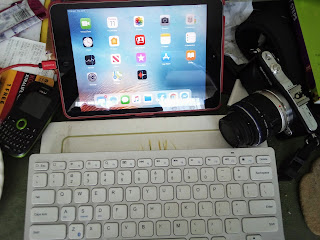There has been a massive and I do mean a massive change in technology over the past 30 years. As a youngster I remember being taken on a tour of the local newspaper. At that time the words were made from cast lead and placed on trays used for printing. Then, the papers had darkrooms and each roll of film had to make it back to the lab, be developed and printed before it could be used. All very time-consuming, expensive and quite polluting.
As I have said on many occasions, there’s sod all difference between most cameras for 99% of all users and usage. Those amateurs that buy hyper expensive cameras then “prove” that they can produce a better image are fooling only themselves. Those that buy brand new kit are fools to themselves too.
Let’s look at the kit above. Ignoring the cellphone which is there just to demonstrate a cellphone (it does work, it cost me $15 and I’m using it as well as my main phone - which I used to take the picture), there’s a 4 year old 7” tablet, a 10 year old camera and lens both of which I bought secondhand, 4 years ago and a cheap Bluetooth keyboard. Even including my main phone which was $40, there’s probably less than two or three days wages for most low-paid people there.
That lot gets used for 90% of my blog postings and has for the past few years. Before I had the keyboard I used to use the terrible onscreen keyboard which led to some hilarious autocorrections. Eventually I’d had enough and added the Bluetooth keyboard.
The more pretentious individual - the type that buys only the most expensive lenses, cameras and other equipment, changing it whenever something new comes out - will, of course turn their snout up at minimalist equipment like this. In fact a few months ago I was at one of the national parks. There, I chatted with a fellow who had hiked to the top of a pretty big hill with a massive camera bag. He was very snooty when he found my camera is “only” 12 megapixels when he had the latest, greatest 50 megapixel monster. There’s no reason for that snootiness, nor for the pretentiousness.
If I truly wanted the latest and greatest, I’d ask myself why. My decision process goes along the lines...
- Most any digital camera produced in the last 10 years or so has ample resolution for most people. Given that very few images are actually printed there’s very little reason for most people to have huge resolutions. Indeed, even a 6 megapixel image printed at 300 PPI would measure 8 inches by 10 inches. 300 PPI is the absolute limit of human vision and quite candidly it would be possible to use lower PPI without anybody really noticing unless their nose was pressed right up against the print. If their nose is pressed against the print, they’re not appreciating the image but trying to find something to moan about.
- All digital cameras will take a decent photo. There are no dogs out there so brand makes no difference nor does model.
- Cost makes a difference. The more you spend on a camera, the less you can spend on anything else.
- New versus used - why take the price hit by buying new? My 10 year old 12 megapixel Olympus PM1 cost me $75 when I bought it, 4 years ago. New that camera cost $400. I saved myself $325 of depreciation. Nothing in photography ever appreciates in value - it all depreciates as fast as a brick falling through space.
- As for lenses - certainly there is a difference, some of the cheaper lenses from independent makers are not that great. They’re soft and blurry. This is why I won’t buy independent lenses. But I won’t buy new lenses either. Again, they depreciate and as long as they work just fine, who cares what they look like.
- At the end of the day the question has to be - do you want to take pictures or do you want to pose? If the answer is to take pictures then an expensive kit is not needed. If it’s to pose then you’ll want to get the expensive stuff but remember posing can only be done for a few months until the next big thing comes out.
The cost of the kit shown is not high because it was all secondhand. The point of it is what can be done with it. I’m done with spending money out the wazoo for things that don’t get used often. I’ve been there, seen it, done it and got the tee shirt. I would really like a long lens for my Olympus. I did get a 45-150 which is about the equivalent of a 90-300 but 300 is just not quite long enough for the longer stuff that I’d want to do. Doublers seem to have gone right off the market so the only solution would be to get a T2 mount lens or an M42 mount lens and the corresponding adaptor. The question is whether even then it would be financially worthwhile. It’s not that I make any money from photography. In fact I don’t think anybody really makes money from photography. They make their money from add-ons rather than photography since everybody with a cellphone can take decent enough pictures - hence, of course, many journalists now do their photography with an iPhone.





